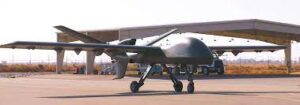“We are providing the ground force with a long-endurance, armed overwatch UAS [unmanned aerial system] that can quickly reload weapons at austere sites, located close to the conflict zone,” General Atomics aeronautical systems CEO Linden Blue said in a release.
The Mojave comes 14 years after the Reaper entered service, and 27 years after the Predator first flew in 1994. (The Gray Eagle, flown by the Army, entered service in 2009, and operates as a better-armed Predator that works well alongside other Army vehicles). These drones, as a family, are hardly new machines—but it has been a long time since a new iteration on the design joined the military.
The Predator started life as an unarmed scout before it added the ability to launch weapons, but it was the dedicated Reaper, built to operate from those long runways with a full load of missiles that really defined the use of drones in the long War on Terror.
“Air Force’s hunter-killer UAV now flying in Afghanistan,” is how the Air Force announced the use of Reapers in that country in May 2007. At the time, and for years afterwards, the US Air Force operated from bases across Afghanistan and Iraq, with combined miles and miles of runway.
This hunter-killer role is central to modern drones, and it is prominent in a request for information made by the Air Force last April. In this solicitation, the Air Force sought new sensors for Reapers and future drones.
Source : https://www.popsci.com/technology/general-atomics-mojave-drone/









